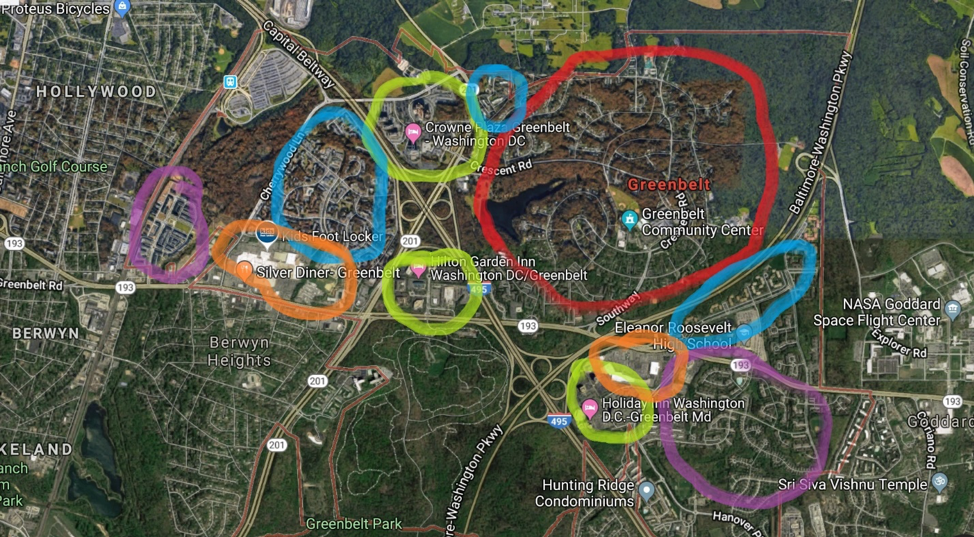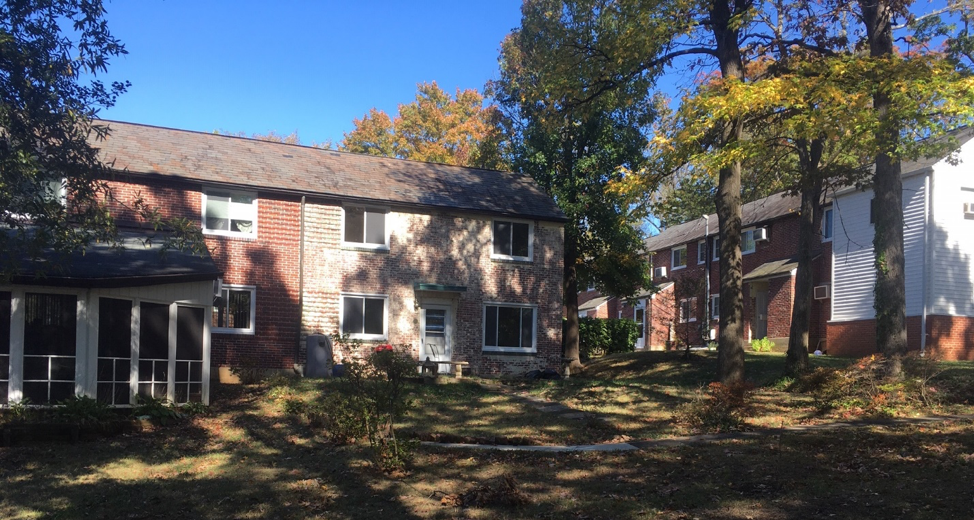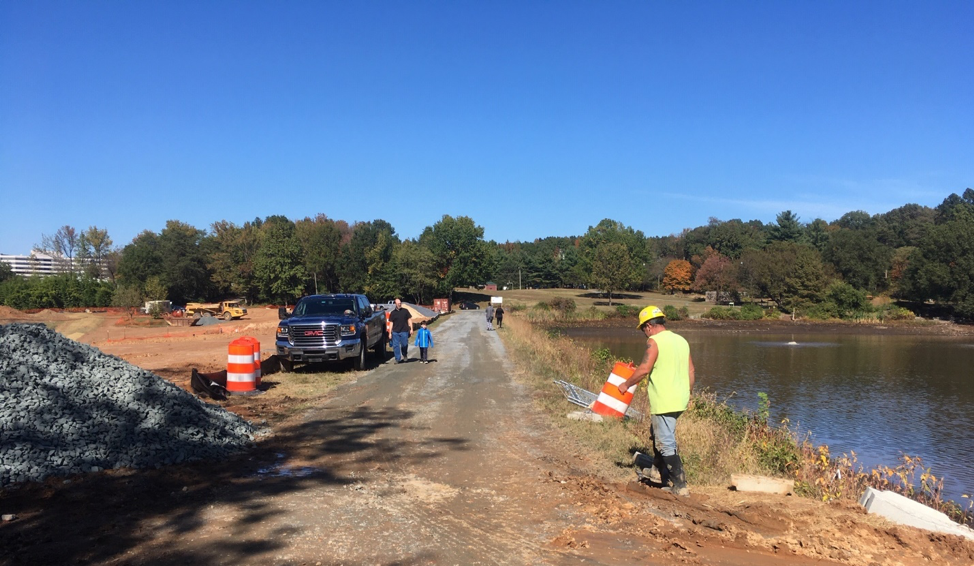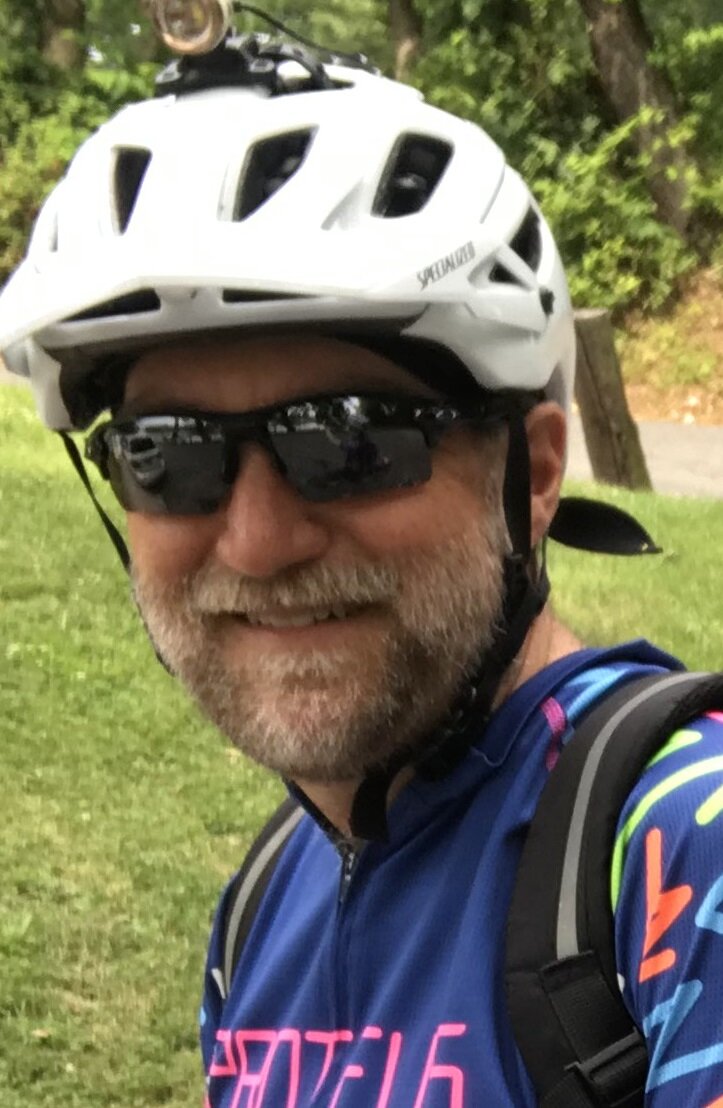From New Deal Utopia to Strong Town
Greenbelt, Maryland, was born in the 1930s. We are one of three “green belt” towns planned to create employment and provide housing during the Great Depression. The town design was more utopian than traditional, with sweeping sidewalks and pedestrian underpasses leading from houses to the community core.
During World War II, the town expanded to provide housing for defense workers; in the 1950s, the federal government sold the whole town to its residents, who continue to own the homes as a cooperative. The landscaping has now matured into a tremendous canopy of trees, and much of the original green belt surrounding the historic town center has been set aside from development as a forest preserve.
After the war, Greenbelt’s historic district — circled in red in the map below — was enveloped by a car-oriented development pattern. By the 1960s and 1970s, the town had been carved into pieces by wide highways and stroads. We gradually incorporated several large pods of apartment and condo complexes (blue circles), three major office parks (green), two large shopping centers (orange), and two major subdivisions of single-family homes and townhouses (purple).
Image source: Google Maps. Markup by the author.
My wife and I moved here in the 1980s. Right out of graduate school, we could afford a down payment on a tiny co-op townhome with a little garden plot on one side and a common area shaded by enormous oak trees on the other. At first, the affordability and walkability were the main attractions. But over time, we’ve come to love the trees.
Can suburban towns like Greenbelt survive the Growth Ponzi Scheme and thrive for generations to come?
My answer is, “I think so.” But I’m very interested in how Strong Towns would “do the math” on older suburban areas like Greenbelt. That’s why I invited the Strong Towns team to Prince George’s county as a part of the ongoing book tour.
On the one hand, we benefit from close proximity to the University of Maryland and NASA — we are home to lots of scientists and teachers. For a suburb, our location suits at least some non-car commuters; we have excellent bike trails to the university and downtown Washington, D.C., and our Metrorail (subway), commuter rail, and bus links are pretty convenient. The proximity to services and walkability make our historic district a naturally occurring retirement community.
Co-op townhomes in Old Greenbelt. Photo by the author.
Housing remains relatively affordable, and, with lots of apartments, condos, and townhouses, our population density per acre is fairly high. We have a county and city income tax to help smooth our reliance on the ups-and-downs of property tax assessments.
We also benefit from state, regional, and county shared funding arrangements for many public services, including education, water/sewer, and parks and recreation. However, with state and county funding comes a loss of local control — we don’t have much say in zoning or development even within our city limits. The state maintains most of Greenbelt’s notorious stroads and bridges, for better or worse (usually worse).
Repairs to the dam and spillway at Greenbelt Lake, funded in part by the state, county, and city of Greenbelt. Photo by the author.
Of course, Greenbelt as a whole is far from a traditional, walkable design. Many parts of Greenbelt are not suitable for easy incremental redevelopment. As a result, we will need to watch our maintenance expenditures very carefully and keep a close eye on state and county funding streams. We don’t have much unprotected land left to develop; our newest housing is being built on abandoned industrial sites and underused parking lots.
Many urbanists write off the suburbs as too insolvent to save. I hope Strong Towns takes a more constructive approach. Prince George’s county has over 900,000 residents. We are very diverse, economically and ethnically. We have plenty of low-intensity sprawl that will be costly to maintain over time. On the other hand, our inside-the-beltway areas are ripe for retrofitting and intensification. Greenbelt is sort of in the middle, with room to more intensely develop our existing infrastructure in some places but not others.
By the middle of the century, Maryland’s hundreds of miles of tidal coastline will be threatened by sea level rise. Greenbelt itself is on high ground, but the state and federal government may have to divert huge amounts of revenues to protecting coastal assets.
Could Greenbelt survive and prosper without as much federal and state funding as the climate changes? With inspiration from Strong Towns, we’re going to do our best. We hope to retire here. We love the community, the location, and the trees. We especially love the trees.
Top photo of Greenbelt’s historic Roosevelt Center courtesy of the author.
About the Author
Jeff Lemieux has been a Greenbelt resident since 1987, and occasionally writes about planning and transportation issues for Greenbelt Online and GreaterGreaterWashington. He’s a bike commuter to DC and was the Washington Area Bicyclist Association’s advocate of the year in 2015. Jeff’s wife Laurie owns Proteus Bicycles in College Park.




